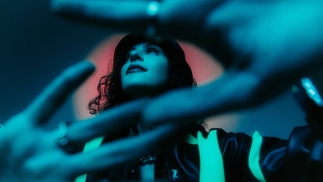AMON TOBIN: THE SOUND OF SCIENCE
Amon Tobin's evolved "Two Fingers" project

Ninja Tune artist Amon Tobin started out experimenting with a double cassette player and ended up piloting the world's most mind-blowing live show. With a new album out under his Two Fingers moniker, we met him in his secluded musical lab and discovered an endless desire to push the boundaries of sound....
“I realise there are people who are deeply resentful about any new turns you want to explore and I do get a perverse kick out of winding those people up,” admits Amon Tobin, the Ninja Tune backed artist who over his 15-year career has risen from sleeping in shady South London studios to emerging as electronic music's most far-out thinker.
Constructing his 2011 album 'Isam' from the ground upwards with a sound palette created in a way that few could imagine, let alone emulate, its synergistic live show has been pushed to the edges of technological advancement, creating a bedazzling display of interstellar incandescence casting Tobin as a space traveller performing inside a video-mapped, multi-cubed 'space ship' stage production.
Making other shows of its ilk look like the impotent fizzing of an indoor firework, the commercial success of 'Isam' — it's thus far toured Europe, the USA, Canada (launching at Mutek and headlining Coachella), Australia and Japan — is all the more exceptional given the increasingly idiosyncratic experimentations of Amon.
Having started making straightforward sample-based tracks, he's evolved into a sonic scientist developing instruments from deliberately chosen and recorded sounds, fashioning these on 'Isam' into a bold meeting point between fierce bass mechanics, delicate lullaby-like melodies and slippery, shifting musique concrete. But while 'Isam' was the pinnacle of years of studio study, his latest release, under the guise of Two Fingers, flips the script again to return to the initial inspiration of his youth.
“When I was a teenager my own first thing was hip-hop,” explains the 40-year-old Brazil-born producer on double album 'Stunt Rhythms' (out now) when DJ Mag meets him in the small secluded town, an hour's drive from San Francisco, where he has his home and studio. “That's where I tried to find my own identity.”
IDENTITY
It's this search for identity that has driven everything Tobin has done since, a back catalogue of eight studio albums, one official live mix, and this year's hefty and exhaustive limited-edition box set of six records, seven CDs and two DVDs, insensible to trends, concessions or anything other than his childlike wonder at exploring and understanding, taking apart and reassembling to drill down into the nature of music and the sounds that make it.
Taken backpacking by his mother when his parents split up, his childhood occupied countries including Morocco, Ireland, Holland and England, the pair sometimes living in squats.
“Back at that time, people were getting organised in that way and getting self-sufficient in some ways that weren't, I guess, the normal way to do it,” a spirit of dogged independence that seems to have guided him around the usual music industry pitfalls.

While his record collection, stacked in a glass-doored room to the side of his studio, contains vinyl echoes of the '60s greats that marked these years, The Beatles, The Rolling Stones, and the psychedelic rock of Brazilian band Os Mutantes, it was while settling (for a spell, at least) in the unlikely surroundings of Hastings that the emanations of black '80s New York touched his life.
“It was kind of a bleak place really, and we didn't have much to do, so we used to get these tapes that came from the States over to London, then eventually filtered down to our shitty place. We'd listen to that stuff and we'd have pieces of lino... I was in a little crew, we used to battle Bex Hill, it was very provincial. But it was great, I loved it. It was Grandmaster Flash, Melle Mel, all the early electro stuff as well.”
The effects of this went beyond inspiring exuberant attempts at windmills, precipitating his earliest attempt at deconstructing the techniques he heard, in this case Grandmaster Flash extending the break on two records, and translating it into something that reflected his own more parochial surroundings.
“My dad was an English teacher, so he had all these tapes for teaching foreign students English,” Amon recalls. “I used to steal his tapes and edit them. I had this twin cassette recorder which was the best thing ever. I got really good at basically splicing and changing the words about so that sentences would say different things. I used to stay up and record the Top 40 on Sunday night, then I'd reorganise that. There were tracks or chorus and verses I didn't like, so I started editing them out to make alternate versions.”
It wasn't until a few years later when he was living in Portugal working as a holiday rep, one of a series of jobs that made him determined never to make music seem like 'work', that Amon saved up for an Akai S01 sampler and was lured back to England, this time along the coast in Brighton, by the nascent sound of jungle, Dillinja and Peshay pricking up his ears with their hyper-speed breakbeats and booming dub subs. “It was a way of taking things that I loved and doing something with them without saying that I'm part of this, do you know what I mean?” he explains on the intrinsic attraction sampling had. “Take blues, for example. I could never authentically make anything that was to do with blues, but I could take a piece of blues, change it and put it in an electronic environment and do something that was valid.”
While his career has been a drive to get the most out of the proliferation of technology (“Am I going to do what I could do earlier, much quicker, or am I going to use the same time to do something different?” he explains on his attitude in an interview from his box-set), the beginnings of it were quaintly antiquated, a friend encouraging him to send off some productions to a couple of labels advertising on the back of a music magazine.
It resulted in his first album, 'Adventures In Foam', under the name of Cujo for Nine Bar Records (“The label had a dual purpose, but they were amazing people,” he explains on the studio where he learnt sound engineering), while working with a second, Streatham-based label HOS inspired the drum & bass track 'Paris, Streatham', which hinted at his love of film by sampling Wim Wenders' classic Paris, Texas.
NINJA
It was when Nine Bar moved next to Ninja Tune on Stoney Street in London Bridge, round the corner from Clink Street which had held some of London's earliest acid house raves, that Amon stepped out under his own name for 'Brickolage' (1997), his label debut and a freaky jazz dismembering journey that starts with the slowed-down breaks of trip-hop before bursting forth into rolling Amens and time-stretching on tracks like 'Chomp Samba' and 'Creatures'. From the outset, though, he maintained his position as cultural outsider, only joining their ranks under his own terms.
“I had a strange view of them when I first went up there,” he says with a grin. “They seemed very trendy, and they were at the time. I was on this scuffed-up, tiny label and they had Stealth at the Blue Note going on. It was all boys with haircuts which I was a bit suspicious of, really!”
After a cagey meeting with Peter Quicke, who co-runs the label, however, he joined and discovered the rare freedom from label interference or commercial pressures that he still has today.
“They really support what I do, but they don't try to influence it in any way. Well, they have from time to time, but that's been fixed! We really understand each other and we have a mutual respect. I mean, they're truly independent and haven't become part of some bigger label.”
Such indulgence could have been risky, but fortunately for Ninja, their trust was rewarded with a run of increasingly accomplished albums, 'Permutation' (1998), 'Supermodified' (2000), 'Out From Outwhere' (2002) and 'Foley Room' (2007), each exploring varying tempos and styles while furthering Amon's movement away from traditional methods of making music.
“There was a time when, if you used a sample, it was important that people recognised where things came from, so that they could see what was happening to it,” he says. “But after a certain point, when you change a sound so much and the grains get so small, it's sort of irrelevant, so I realised at that point I didn't need to be using samples, I could take sounds from anywhere.”

NATURAL WORLD
While on 'Foley Room' this involved breaking an instrument down into its component parts, realising a snare drum is “a resonant chamber, it's a piece of skin, it's a spring”, and trying to recreate this through field recordings — one stunt involving Amon carrying a buzzing bees' nest trapped under a glass bowl to the studio to sample for the sound of a surf guitar on 'Esther's' — by 'Isam' he was breaking down sounds to create new instruments.
“Basically any sound is made up of a series of sines, partials, which are sine waves that make up the different frequencies of the sound,” he says getting into the science part and returning to the ever-chipped at rock face of his curiosity. “Those can be synthesised with sums of sine waves. So you analyse the sound wave into a synthesised version of it, and suddenly you have a lot more flexibility.”
If you're as confused as we are, then the layman's explanation is revealed on a YouTube video accompanying the release of 'Isam', where the sound of clinking bulbs, a spring and a creaking chair are combined via a piece of software most often used in film sound design to forge an idiosyncratic cyborg instrument, its creaking, rolling slurp, part organic, part mechanical.
Though his home now falls into the mould of 'house in the woods', surrounded by trees and only reachable by car, with a single shop serving him and his neighbours, Amon says this connection to nature has nothing to do with being a country person or “tree hugger”.
“Even if you want to draw a realistic picture of a jar, you have to look at how light works and how perspective works. Then you become much more aware of natural phenomena and how that works as you're analysing it to make your replica of it.
“I find it really interesting how there are certain patterns in nature. When you synthesise something, you have to study what it is that you're trying to replicate. At that point, you start to see all these patterns, like with harmonics, there is a scale and there is a pattern. They are universal and you can see it in the leaves of the trees.”
Again, this could suggest some of the hippie philosophies of San Francisco have floated across on the city's famous microclimate, but Amon hasn't let his artistic independence or purity of vision stop him from courting commercial work, licensing tracks to the remake of The Italian Job, breaking into film soundtracks and being one of the first to work with computer designers, such as on his 2005 album 'Chaos Theory — The Soundtrack To Tom Clancy's Splinter Cell'.
“People get things a bit twisted and think commercial appeal somehow detracts from artistic integrity. I don't think that's true,” he says with a well-worn reply. “Money, for example, isn't what restricts art. Traditionally, money is what supports art. The only thing I think that constricts artistic integrity is compromise, so if you're compromising what you do – if I make a shit track because I want it to work in this Coca-Cola commercial — then I've got some issues.”
CINEMATIC
Unfortunately, for someone who once stated that his wish was “to make a full soundtrack for a really good film”, Hollywood has proved an area where money exerts a bigger pull than artistic reputation. “It's not even a moral thing, I'm just shit at it,” he replies on handling the inevitable requests for changes that accompany big budgets. “So I've worked on films where the director and me have had direct contact, we both understand what we need to do and it's a small production and they take a lot more risks.”
In its place, 'Isam' is his great debut as an auteur instead, Amon providing the soundtrack, orchestrating its visual aspect and taking the starring role as the space-suited controller who sporadically appears at the centre of the action. “It is a completely immature teenage fantasy story,” laughs the guy who lives down the road from George Lucas' Luke Skywalker Ranch and often pops down to watch films, “but I am basically a nerd, so I feel completely justified doing that.”

Still, it almost never happened. Not wanting to tour 'Isam' as a DJ, which Amon had done for previous albums, he was encouraged by Ninja to explore other avenues, and having seen primitive versions of video-mapping, set out to create something more narrative with the help of architect Heather Shaw and LA based company V Squared.
Now in its second phase, it's impossible to do justice to the strobing, shifting kaleidoscope of imagery that compliments the fluidity of the album when we catch the show in the stone nobility of Berkeley's Greek Theater. Now boosted by features including an array of animatronics, such as arms built from bicycle chains, the cubes on stage literally seem to melt and explode, morphing into different textures and environments.
“The whole set is really heady, so it's good to have release at the end of the night,” recognises Tobin after testing the first phase, which brings us back to Two Fingers.
“What I've been doing when the main part of the show ends is coming back to do a half-hour set. It's me just rocking out some Two Fingers stuff as a thanks to everyone at the end of the night.”
TWO FINGERS
Indeed, it's an explosive climax that starts the dance in earnest, as tracks like 'Defender Rhythm' switch between drum & bass and abrasive half-step, highlighting the smoking, skull-marked, industrial strength of the album's first disc. Packed with three-minute bangers, 'Magoo' and '101 South' render jiggy hip-hop as produced by Noisia, 'Lock86' sounds like Drexciya if they'd grown up as Hackney free-party tech-step heads and 'Little Brat' could almost be Skrillex if he'd had an education from the European underground.
It's a departure from Two Fingers' previous releases, which grew out of a “love affair with Timbaland and The Neptunes” and Amon shared with friend Joe Chapman, absent from the controls this time around. “It's just the one finger at the moment. Joe is hopefully going to come back and do more stuff if I make more Two Fingers records. He's really talented, so I hope we'll do more stuff together.”
The second disc is equally cranked, but introduces US MCs Peedi Crakk, Chinko da Great, Lady Pharroh and Brefontaine to the process, Two Fingers having previously worked with UK rapper Sway, testing Amon's cut 'n' paste entrenchment, but adding another dimension to the ride. “Joe and I would always have this battle. He's really into hip-hop and MCs, and I'm just into the sound. I'd always approach the vocal as, I don't even care what they're saying, I just want it to work phonetically or rhythmically with the beat. They can say the same word over and over again for all I care.”

Watching America's current obsession with ever-heavier sounds from afar, 'Stunt Rhythms' could be exactly the album to follow the interest generated by Amon's live show, palatable to the brostep crew who at one dubstep-dominated festival sat down baffled when confronted by 'Isam' in its previous incarnation. But if this is the case, then the timing is purely down to Amon's own inner compass, rather than any commercial calculation.
“I feel so strongly against that,” he says on the tendency of artists to come to see themselves as entertainers. “That is the definition of selling out for me. It's trying to pander to your fan base. What are the odds that you can read these people's minds and really know? From my first album there's been an equal amount of love and hate.
“I'm not raging against the machine or anything,” he continues when we delve into what might lie further down the line, “it's motivational. The first pieces of music I sent out that I mentioned earlier, I was thinking, 'How can I make a living out of music, how can I make this appeal to people?' And I made the most awful shit, it was just terrible, so I wasn't satisfying anyone.
“Maybe there are people more skilled at that, who can read the general consensus a bit more intuitively. I'm just not one of those people. It's good that it's working out so far, but we'll see down the line. I might do my dubstep megamix. Who knows? I doubt it. The next record will probably be a continuation, so we'll see where that goes, really.”
Having experienced his boundless desire to explore the deepest, furthest reaches of music and beyond, we'll be first in line to follow.





